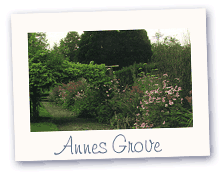 |
Search the site:

Annes Grove, County CorkThere are few gardens anywhere in Ireland where rare trees and shrubs are grown so successfully and in such a harmonious setting as the beautiful Robinsonian garden of Annes Grove. Set on a sloping site around an elegant early eighteenth-century house overlooking the River Awbeg, the thirty-acre garden is filled with thousands of thriving plants in a layout that merges unobtrusively into the landscape. In front of the house stretches a parkland with some fine trees; nearby is a walled garden with herbaceous borders, yew walk, rock garden and water garden; beyond in an extensive woodland garden noted for its rhododendrons; and down below in a wooded limestone gorge is a lovely river garden with an island, stony rapids, rustic bridges and a lush tapestry of green foliage.
Some trees still survive at Annes Grove from the formal layout associated with the early eighteenth-century house, then known as Ballyhemock, that Lieutenant-General Grove Annesley built here on land he had inherited from the Grove family. The informal park was created in the late eighteenth century, but after this date only minor alterations occurred at Annes Grove until 1900 when Richard Grove Annesley (1879-1966) came of Richard Grove Annesley's interest in gardening may have originally stemmed from visits to Castlewellan where his cousin, the fifth Earl of Annesley, had created one of the greatest arboreta of the age; but it was his lifelong friendship with the fourth Marquis of Headford, one of the great garden enthusiasts of his time, that encouraged Grove Annesley to develop his knowledge of plants. Headford was a personal friend and patron of the plant collector George Forrest, and following his example Grove Annesley joined in the sponsorship of plant hunting expeditions to the Himalayas and beyond. Seeds collected by Forrest and Kingdon Ward, notably rhododendrons, duly arrived back at Annes Grove, and these together with numerous plants exchanged with other gardens were used to create a garden in the 'wild' style initiated by William Robinson-the eminent Irish gardener and writer who advocated suiting the garden to the terrain and the plant to the location. After the death of Grove Annesley in 1966, the formidable task of maintaining the gardens fell upon his son, the late E. P. Grove Annesley, and are now being successfully conserved by his grandson, Patrick Grove Annesley, the present owner of Annes Grove. The visitor will first notice the Victorian plantings. Along the avenue are some fine mature trees, including an Abies magnifica from California at least sixty-six-feet high and a Japanese Yezo spruce (Picea jezoensis) some fifty-feet tall. Close to the house is a fine Cedrus deodara from the Himalayas underplanted with cyclamen, a huge Rhododendron ponticum and a variety of interesting shrubs, many from South America, bordering a spacious lawn. The house front itself is covered with the evergreen Euonymus fortunei and the deciduous Actinidia chinesis, notable for its heart-shaped leaves and cup-shaped white flowers in summer. > > > Read the final part in this article From the Appletree Press title: Irish Gardens. |
All Material © 1999-2005 Irelandseye.com and contributors

 age and inherited the property. Over the next sixty years he was to develop Annes Grove into one of the great gardens of Ireland.
age and inherited the property. Over the next sixty years he was to develop Annes Grove into one of the great gardens of Ireland.